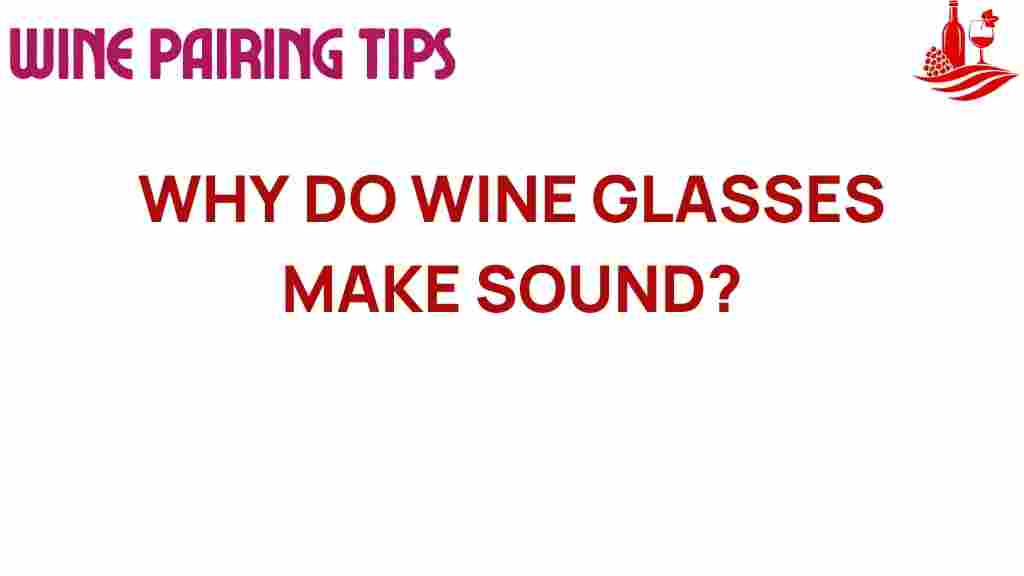Unveiling the Mystery: Why Do Wine Glasses Make Sound?
When you clink your wine glasses together in a toast, have you ever paused to wonder why they make that delightful sound? The enchanting acoustics of wine glasses are not just a charming aspect of wine culture; they also enhance the tasting experience. This article delves into the science behind the sounds of wine glasses, exploring the vibrations, resonance, and sensory perception that contribute to our enjoyment of wine. Join us on this fascinating journey as we uncover the mystery of why wine glasses produce sound.
The Science of Sound and Wine Glasses
To understand why wine glasses make sound, we must first explore the fundamental properties of sound itself. Sound is produced by vibrations that travel through a medium—usually air. When you strike a wine glass or swirl wine within it, you create vibrations that resonate, producing sound waves. The characteristics of these sound waves depend on several factors:
- Material: The type of glass used affects how sound travels through it. Crystal glasses, for example, tend to produce clearer and more resonant sounds.
- Shape: The shape of the glass influences the pitch and tone of the sound produced. A wider bowl may create a lower tone, while a narrower rim can produce higher pitches.
- Contents: The liquid inside the glass also plays a role. Different wines can absorb sound waves differently, altering the resulting acoustics.
The Role of Vibrations in Wine Glass Sounds
Vibrations are the heartbeat of sound. When you lightly tap a wine glass, the impact creates a series of vibrations that travel through the glass. These vibrations resonate within the glass body, producing sound waves that we perceive as musical tones. The frequency of these vibrations determines the pitch of the sound:
- High Frequencies: These are produced by faster vibrations, often resulting in a higher-pitched sound.
- Low Frequencies: Slower vibrations produce deeper, bass-like sounds.
The resonance of the wine glass is crucial. Resonance occurs when the frequency of an external force matches the natural frequency of the glass, amplifying the sound. This is why gently swirling wine in a glass or striking it produces such rich, vibrant sounds—you’re essentially tuning the glass to resonate at its optimal frequency.
The Influence of Acoustics on Tasting Experience
Wine tasting is not just a visual and olfactory experience; it is also deeply auditory. The sounds made by wine glasses can enhance the overall enjoyment of wine. Here’s how:
- Setting the Mood: The gentle clinking of glasses can create an atmosphere of celebration and camaraderie, enhancing the enjoyment of the wine.
- Engagement of Senses: Sound is a powerful sense that can evoke emotions and memories, making the tasting experience more memorable.
- Enhancing Flavor Perception: Some studies suggest that certain sounds can influence how we perceive flavors, creating a more rounded and enjoyable tasting session.
Exploring Wine Culture Through Sound
Wine culture is rich and varied, and the sounds associated with wine play a significant role in its social and cultural contexts. From the clinking of glasses during a toast to the sounds of wine being poured, these auditory elements contribute to the overall experience:
- Celebratory Sounds: Clinking glasses symbolize unity and celebration, often marking significant moments in gatherings.
- Art of Pouring: The sound of wine pouring into a glass can create anticipation and excitement, enhancing the ritual of tasting.
This soundscape of wine culture enriches the experience, creating lasting memories associated with gatherings and celebrations. It forms a part of our sensory perception, making the enjoyment of wine a holistic experience.
How to Enhance Your Wine Glass Experience
To truly appreciate the sounds of wine glasses, consider the following tips:
- Choose Quality Glassware: Opt for crystal wine glasses that are designed to enhance acoustics and resonance.
- Experiment with Different Wines: Try various types of wine and observe how the sound changes with different liquids.
- Practice Tapping Technique: Gently tap or swirl your glass to experience the range of sounds it can produce.
Troubleshooting: When Your Wine Glasses Don’t Sound Right
Sometimes, you may find that your wine glasses don’t produce the expected sounds. Here are some troubleshooting tips to help you out:
- Check for Cracks: Inspect your glass for any cracks or chips, as these can dampen sound quality.
- Ensure Cleanliness: Residue or dirt can affect sound production. Clean your glasses thoroughly before use.
- Try Different Techniques: Experiment with different tapping techniques or amounts of wine to see how it affects sound.
Conclusion: The Joy of Sound in Wine Culture
Understanding why wine glasses make sound enhances our appreciation of wine, integrating the auditory experience into the overall tasting journey. The interplay of vibrations and acoustics in wine glasses not only elevates our enjoyment but also deepens our connection to wine culture. The sounds of clinking glasses, swirling wine, and pouring liquid contribute to a sensory perception that goes beyond taste and aroma.
Next time you raise your glass for a toast, take a moment to absorb the sounds around you. Embrace the vibrations and resonance that come with your wine glasses, and let them enhance your tasting experience. After all, wine is not just about flavors; it’s about the entire experience, sound and all.
For more insights into wine culture and tasting experiences, check out this guide to enhancing your wine enjoyment. Dive deeper into the world of wine and discover how sound plays a pivotal role in creating unforgettable moments.
Additionally, if you’re interested in the science behind sound, you can explore more about vibrations and acoustics in this comprehensive article that will broaden your understanding of sound in various contexts.
This article is in the category Tasting and created by Wine Pairing Tips Team
